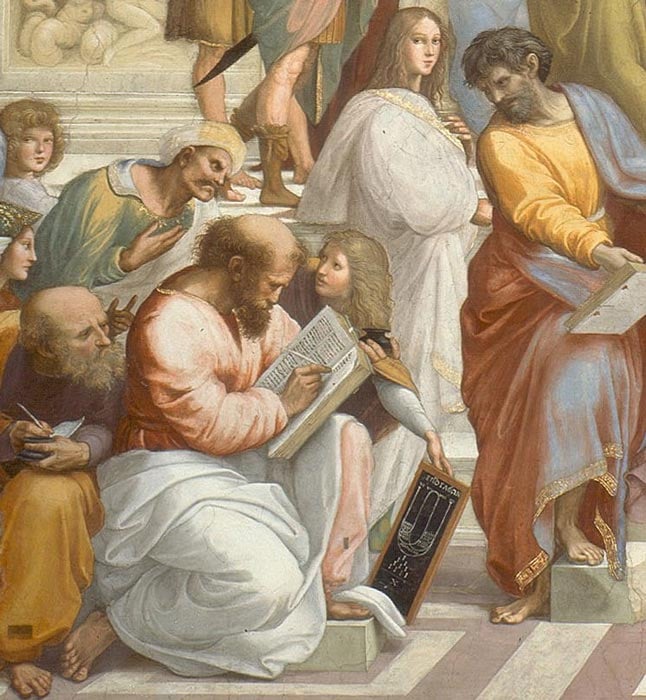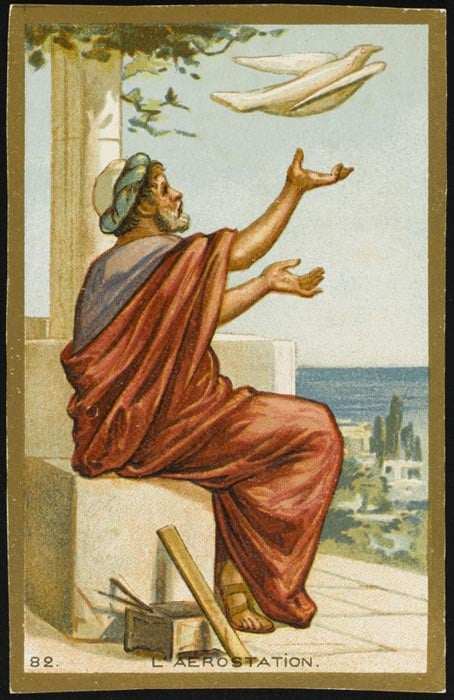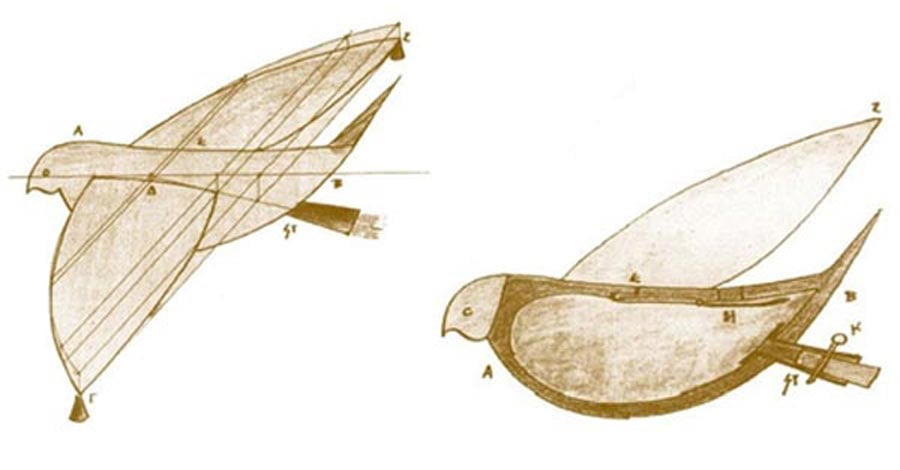The Steam-Powered Pigeon of Archytas – The Flying Machine of Antiquity
Archytas was an ancient Greek philosopher, who was born in 428 BC in Tarentum, Magna Graecia, now southern Italy. In addition to being a philosopher, Archytas was also a mathematician, astronomer, statesman, and a strategist, best remembered for inventing what is believed to be the first-ever self-propelled flying device known as the Flying Pigeon.

Archytas became a Pythagorean, fascinated by arithmetic, mathematics and geometry. Raphael’s fresco, The School of Athens, shows Pythagoras as a young man. (Public domain)
Explaining the World Through Mathematics
When Archytas was young, he was taught by Philolaus. Over time he became a Pythagorean, believing that only arithmetic could provide a basis for satisfactory proofs, and that this could not be accomplished via geometry. He even taught mathematics to Eudoxus of Cnidus and Menaechmus.
To Archytas, everything revolved around and could be explained by mathematics. He viewed mathematics as being broken into four branches: geometry, arithmetic, astronomy and music. In a preface to one of his writings (identified by some as “On Mathematics” and others as “On Harmonics”), Archytas wrote:
Mathematicians seem to me to have excellent discernment, and it is not at all strange that they should think correctly about the particulars that are; for inasmuch as they can discern excellently about the physics of the universe, they are also likely to have excellent perspective on the particulars that are. Indeed, they have transmitted to us a keen discernment about the velocities of the stars and their risings and settings, and about geometry, arithmetic, astronomy, and, not least of all, music. These seem to be sister sciences, for they concern themselves with the first two related forms of being [number and magnitude].
Archytas served well in leadership positions. At one point, the Pythagoreans were attacked and expelled from Magna Graecia, with the town of Tarentum left as their only relative safe house. Archytas became a leader of the Pythagoreans in Tarentum, and tried to unite the Greek towns in their area to form an alliance against non-Greek neighbors.
Although under Tarentum law one person could only hold the post of commander-in-chief for one year, Archytas was elected into the position for seven consecutive years. During this time he was close friends with Plato, and it is believed that he saved Plato’s life at one time.

Archytas and his steam-powered flying pigeon. (Archivist / Adobe Stock)
Archytas and his Steam-Powered Flying Pigeon
It is said that Archytas’ most important contribution was that he was the founder of mathematical mechanics. He was the inventor of what is known as “the first autonomous volatile machine of antiquity” – or the flying pigeon to put it simply.
Archytas’ steam-powered flying pigeon was a highly advanced invention for his time. It was called the flying pigeon because its structure resembled a bird in flight. It was built of wood, and was one of the first attempts to understand the way in which birds manage to fly.
The lightweight body of the flying pigeon was hollow and cylindrical in shape. It included wings projected out to either side, and smaller wings to the rear. The front of the object was pointed, like a bird’s beak. The shape of the structure was very aerodynamic, for maximum flying distance and speed.
![]()
Meanwhile, the rear of the flying pigeon had an opening that led to the internal bladder. This opening was connected to a heated, airtight boiler. As the boiler created more and more steam, the pressure of the steam eventually exceeded the mechanical resistance of the connection, and the flying pigeon took flight. The flight continued for several hundred meters.
Invented some time between 400 and 350 BC, the steam-powered flying pigeon created by Archytas is sometimes referred to as the world’s first robot. It’s also the first instance on record of research into how birds fly. The Kotsanas Musem of Ancient Greek Technology has created a reconstruction of what the flying pigeon would have looked like.

Reconstruction of the steam-powered flying pigeon. (Kotsanas Musem of Ancient Greek Technology)
The Death and Legacy of Archytas
It is believed that Archytas died in a shipwreck in 347 BC near the shore of Mattinata. His body lay unburied until a sailor cast a handful of sand upon it, so that Archytas would not have to wander on this side of the Styx for a hundred years. This story was never verified.
Even after his death, Archytas’ works live on. His significant contributions to mathematics and mechanics remain useful to this day. Although the extent of his philosophical relationships is not known, it is said that Archytas influenced the works of both Plato and Aristotle. A crater on the moon has been named Archytas in his honor. It is clear that his contributions to modern society, including mathematical advances and the flying pigeon, were significant.
Top image: The steam-powered flying pigeon of Archytas. Source: YourForum
By M. R. Reese
References
No name. 5 November 2020. “Archytas” in Stanford Encyclopedia of Philosophy. Available at: http://plato.stanford.edu/entries/archytas/
No name. No date. “The flying pigeon of Archytas” in Kotsanas Museum of Ancient Greek Technology. Available at: http://kotsanas.com/gb/exh.php?exhibit=2001001
Hiskey, D. 14 November 2012. “First robot created in 400 BC was a steam-powered pigeon” in Mental Floss. Available at: http://mentalfloss.com/article/13083/first-robot-created-400-bce-was-steam-powered-pigeon


















Comments
Interesting story. This is the first meaningful attempt to explore aerodynamics. It looks like the purpose may not have been for pure scientific curiosity, but rather to gain a military advantage, increased range over an arrow. The inventor was a very general (reappointed many times because he won battles for the state). None the less it is interesting and this method is used to this day, catapults are used to accelerate fighters to a take-off speed in the limited length on an aircraft carrier, kids learn of rocketry using pressurised coke bottles.
Those interest in ancient flight, should look at the flying monk (circa 1000AD) Eilmer of Malmesbury, a Turk accredited with a much better controlled flight 400 years before this in Spain, but there are no substantial records to confirm this. The Chinese had rockets around this time and the first propeller (spinning top – kids toy). There are also accounts of adepts (masters of simplicity) that flew and there is a remarkable passage of how to build a glider. The emperors were trying to learn how to do it, using man lifting kites (prisoners were test pilots, most did not survive). SO there may be some truth in the legion of Daedalus and Icarus (a tale also informing of the danger of invention, the world is better off without some things). I just wonder if they did get a basic glider flying. They had the materials to do it. They imported flax (linen), from Egypt, they had the best weaves in the world producing fine cloth, actually Aero linen was used for the first aircraft, the wax would have been to seal the cloth. Beams at the leading and trailing edge and stabilisers at the back and off you go from the side of a hill. This is what the Chinese describe, Jujube is basically balsa wood. The dragons, oxen, snakes could be referring to planform areas (likely) or kite types, they are not likely to be literally skins. Humans have been wanting to fly for a long time. Just imagine what a population would think of those that could, Gods. By the way, Daedalus is unlikely to refer to one person, he just invented too much stuff, it is more likely to be a Minoan rank, the equivalent of chief engineer, that built buildings, produced fine art pieces, developed technology and engineering methods (metallurgy, ships, chariots etc).
Interestingly the tail of Talos, might be based on an actual technology (not dissimilar to the steam powered projectile described) that could not be explained by the Greeks. There is a weird casting of a large (5m length) cylinder with operators on it. No-one knows what it is, it looks like a huge boiler, the Minoans had hot water going to palace buildings as well as underfoot heating, aqueducts and sewers and water pipes. I just wonder if they had steam (the device is sealed and appears to have controls), if so they could have used it for a piston to hurl rocks at approaching ships (possibly further than a catapult), which is described in quite a few stories. Daedalus is accredited with automatons (basic robots), but these are more likely to be moving statues, but he is accredited as the maker of an automatic remotely controlled door that opened using a fire (badly explained, this suggest steam and valves, a fire alone will not do it). Historians simply didn’t have the language to explain technology. The greek mythology is actually focused around the Islands, controlled by the Minoans and I suspect they had an asymmetric trading network, they didn’t let ships with the wrong flag enter their ports, they didn’t need heavy fortification for their palaces either, it suggests they could intercept any vessel or fleet before it reached their ports and the mythology suggests they launched bolts at approaching ships using machines, to keep them away and maintain their own trading advantage, hub with access to all the worlds useful commodities. Zeus/Athena(in particular) had thunder bolts, now where was Zeus born and where did he die – yes he did die, there was a grave, he was just a leader, but if you had this power maybe you would be perceived as a god by other nations, the Minoans didn’t treat him as one, just a respected leader). Talos circling Crete three times a day, could actually mean that the entire island was protected and was under the control of the three main centres (east – sun rise (venus), west sunset and moon goddess (mistress of animals – Athena type) and centre Knossos mother goddess (Hera) and the priestess keeping an eye on all the shipping lanes! The snakes are probably referring to the Draco and pole star, it looks like they understood a lot about the celestial bodies, time and seasons (they had an advanced calendar probably learned from the Babylonians based on humanising the sun and moon cycles). The snake Draco rotates around the earths axis, handy if you need to navigate. The iconography and artefacts support this. The peak sanctuaries are all at elevated positions with great visibility over the oceans. A double axes can signal over significant distance to the operators of catapults to lay down fire and direct ships to intercept. A hand mirror can be seen from about 50kms for example (the axe surface is much larger and substantially flats, this distance is enough to signal another island that also had peak sanctuaries, these could explain how they ruled the seas and directed the navy), 200m elevation (many of the peak sanctuaries are higher) gives you about this range to the horizon. The double axe is misunderstood, it can be used for both signalling and measurement of angles (including navigation) – they all have incremented marks on them, they were studying the stars and looking after their coastal approaches as well, these were mass produced items, there are even portable ones with eyelets at the end, they are made from gold, silver and copper, all highly reflective, attach a string, spin, it reflects the sunlight and casts a shadow. Mark the length throughout the day, at the shortest length, this is mid day 12.00 exactly. The shadow cast points directly North, the length tells you your latitude, the larger axes may use a month offset to take account of the earth axis but I don’t fully understand this yet. Now how big was their trade network, Egypt, Asia, to the pillars of Hercules and beyond, even up to Spain and the Cornwall to get tin (there are graves in Scottish border (trade route to the highlands and islands) with stone covered in axes – to cast on the inside and linear a found at a Scandinavian silver mine), you need to be able to navigate to do this distance! The only other tin is in Afghanistan, even further and yes they also traded with them too, they crafted Lapis Lazuli that only comes from this part of the world, they controlled all the key commodities, processed them into even higher value items, weapons, the finest cloth, the most beautiful furniture, jewellery and art and exported this to those with other commodities they needed. If you look at the art, the double axes are shown in the context of so called bull horns of consecration, duh, the bulls horns are regularly positioned on the buildings which all cast a shadow to an axe in the court yard, count the horns shadows to the axe, you know the time of day. Thats my take anyway for debate. Sorry a bit wordy, going a bit of topic and got carried away, I work on flight/propulsion systems, solar power and like my technology, ancient or modern.
Anyone build this pigeon to see if it would fly ? Like to see it :)